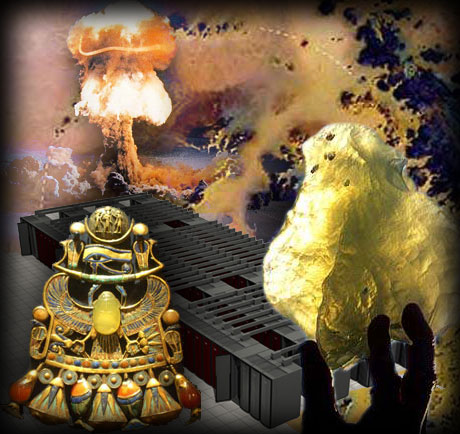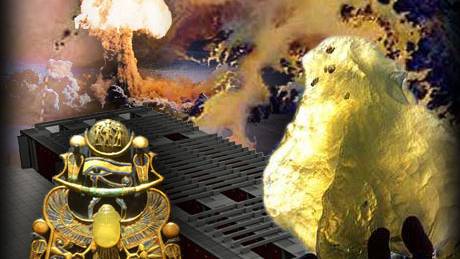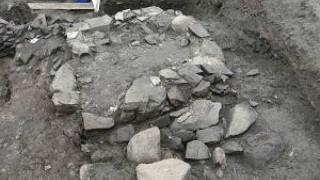Sandia Supercomputer Helps Researchers Discover Origin of Mysterious Glass Found in King Tut's Tomb
Source: macroworldinvestor.com

Evidence for Ancient Atomic War?
Global supercomputer leader Cray Inc. today announced that researchers running simulations on the Cray supercomputer at Sandia National Laboratories have re-created what could have happened 29 million years ago when an asteroid explosion turned Saharan sand into glass. The greenish natural glass, which can still be found scattered across remote stretches of the desert, was used by an artisan in ancient Egypt to carve a scarab that decorates one of the bejeweled breastplates buried in King Tutankhamen's tomb.
"Supercomputers now allow us to approach these problems as if we were conducting actual experiments," said Mark Boslough, the physicist at Sandia whose theory about the origins of Libyan Desert Glass sparked the research. "With this class of computer, we can run multiple simulations at such high resolution and fidelity that we can see phenomena that we wouldn't be able to predict from first principles. That means we can explore alternate possibilities as we go. It's more like doing iterative experimental science than theoretical science."
The Cray supercomputer at Sandia, nicknamed Red Storm, was developed jointly by Cray and Sandia, a part of the Department of Energy's National Nuclear Security Administration. Sandia upgraded Red Storm late last year to three times its original performance level, boosting its performance to more than 100 teraflops, or 100 trillion floating point operations per second. Red Storm is one of only three supercomputers in the world to exceed the 100 teraflops mark, according to the TOP500 results released last month.
"The Libyan Desert Glass study at Sandia is truly exciting research that crosses a number of scientific disciplines -- ranging from impact physics and geology to Egyptology," said Jan Silverman, senior vice president, corporate strategy and business development at Cray. "We are delighted to hear about how our highly scalable Cray XT(TM) supercomputer architecture allows iterative modeling techniques to find the most probable explanation. Using the computational power of our supercomputers we also see similar iterative techniques being used to optimize designs from automobiles to airplanes."
Clues To a Mystery
Until recently Earth scientists believed that natural glass can form by only two high-temperature processes. Volcanic glass, such as obsidian, can be produced when lava cools rapidly. Or, in rare cases, a glass known as tektite can form from the high pressures generated when an asteroid or comet directly impacts the earth. But compositional studies indicate that Libyan Desert Glass does not fit either of these two categories. Adding to the puzzle, scientists generally agree the Libyan glass was somehow formed by a collision with an object from space, but no one has ever been able to confirm an impact crater in the region.
Boslough found one clue to the glass mystery in the 1994 collision between the Comet Shoemaker-Levy 9 and Jupiter. That comet broke up into several pieces before it made contact with Jupiter's atmosphere, where the collisions caused fireballs that shot hundreds of miles above the planet. Boslough conjectured that if such an air burst were to occur above Earth, it might generate enough heat to fuse surface materials into glass.
Another clue was the Tunguska explosion that flattened a thousand square miles of forest across Siberia in 1908. Because there is no crater of sufficient size to have caused this event, it is generally believed that the Tunguska blast was the result of a meteoroid or comet fragment that exploded at an altitude of five to 10 kilometers (three to six miles) above the Earth's surface.
Boslough argues that a similar atmospheric explosion could have created fireballs large enough and hot enough to produce the Libyan Desert Glass. Such glass would have been forged in seconds, much like the glass that formed from super-heated sand at the Trinity site in New Mexico during the first atom bomb test in 1945. If the asteroid blast occurred above the Earth, there would be no evidence of a collision in the composition of the glass and no significant crater in the ground.
Re-creating the Blast
"What I focused on in the simulations was the explosion of the asteroid," said Boslough. "As the object entered the atmosphere it had tremendous kinetic energy. Much of that energy was converted to heat, creating a blast as hot as the surface of the sun over a large area. The fireball remained in contact with the Earth's surface for more than 20 seconds. At the same time, winds behind the blast reached a speed of several hundred meters per second. The glass formed from the rapid melting and quenching of the sandstone and alluvium on the ground."
Boslough and his colleagues at Sandia performed high-resolution hydrocode simulations on Red Storm using the CTH shock-physics code. They postulated a 120-meter diameter stony asteroid hitting the atmosphere at 20 kilometers per second and breaking up, touching off a blast equivalent to a 110 megaton bomb and producing intense heat and high-velocity winds.
According to the simulations, this explosion would have been more than sufficient to melt rocky material on the surface and then cool it quickly, the conditions necessary to form natural glass. The high winds would have accelerated the melting process by blowing away the boundary or "melt" layer that would otherwise insulate the stone from the heat.
Boslough and his group conducted a number of simulations to come up with their results.
"Multiple iterations are really important for gaining new insights," he said. "You can't plan out your whole experimental matrix and lock yourself in. When we vary the parameters, we can see new things. For example, we observed a large ring vortex during the explosion that acts as a 'lubricant' for the downward flow of mass and energy. No one had suggested that was possible before."
For more information about the Libyan Desert Glass study, go to sandia.gov.
About Sandia National Laboratories
Since 1949 Sandia National Laboratories has developed science-based technologies that support U.S. security. The laboratory primarily focuses on nuclear weapons, energy and infrastructure assurance, nonproliferation verification, defense systems and assessments, and antiterrorism. Go to www.sandia.gov for more information.
About Red Storm
Commissioned by the U.S. Department of Energy and National Nuclear Security Administration to address computing and simulation requirements, Cray and Sandia National Laboratories jointly produced the Red Storm supercomputer. Red Storm is a massively parallel processing (MPP) supercomputer with distributed memory, multiple instruction and multiple data architecture to provide exceptional computational power. It is not only one of the world's fastest supercomputers, but offers ease of use, system balance, sustained performance and reliability. The Red Storm design became the basis for the Cray XT series of MPP supercomputers, which are in use today at a number of prestigious supercomputing centers around the world. Go to http://www.sandia.gov/ASC/redstorm.html for more information.
About Cray Inc.
As a global leader in supercomputing, Cray provides highly advanced supercomputers and world-class services and support to government, industry and academia. Cray technology enables scientists and engineers to achieve remarkable breakthroughs by accelerating performance, improving efficiency and extending the capabilities of their most demanding applications. Cray's Adaptive Supercomputing vision will result in innovative next-generation products that integrate diverse processing technologies into a unified architecture, allowing customers to surpass today's limitations and meeting the market's continued demand for realized performance. Go to www.cray.com for more information.
Cray is a registered trademark, and Cray XT is a trademark of Cray Inc. All other trademarks are the property of their respective owners.
Cray Media:
Erin McGhee
206/701-2107
pr@cray.com
Cray Investors:
Vic Chynoweth
206/701-2094
ir@cray.com
Copyright 2007 Market Wire, Incorporated
Article from: http://www.macroworldinvestor.com/m/
m.w?lp=GetStory&id=264072231






















